Unit 5 Management Accounting Report: Warburtons Analysis
VerifiedAdded on 2023/01/13
|27
|6369
|23
Report
AI Summary
This report provides a comprehensive analysis of management accounting principles and their practical application, using Warburtons the bakers as a case study. It begins with an introduction to management accounting, its objectives, and its comparison with financial accounting. The report then delves into management accounting systems (MAS), including cost accounting, inventory management, job costing, and price optimization systems, along with their benefits and integration within Warburtons' business processes. Furthermore, the report explores various management accounting reporting methods and techniques, such as marginal costing, absorption costing, and standard costing with variance analysis. The report also examines how these techniques can be used to address financial problems within an organization. The analysis includes detailed explanations, advantages, disadvantages, and real-world examples, offering valuable insights into the practical application of management accounting in a business context.
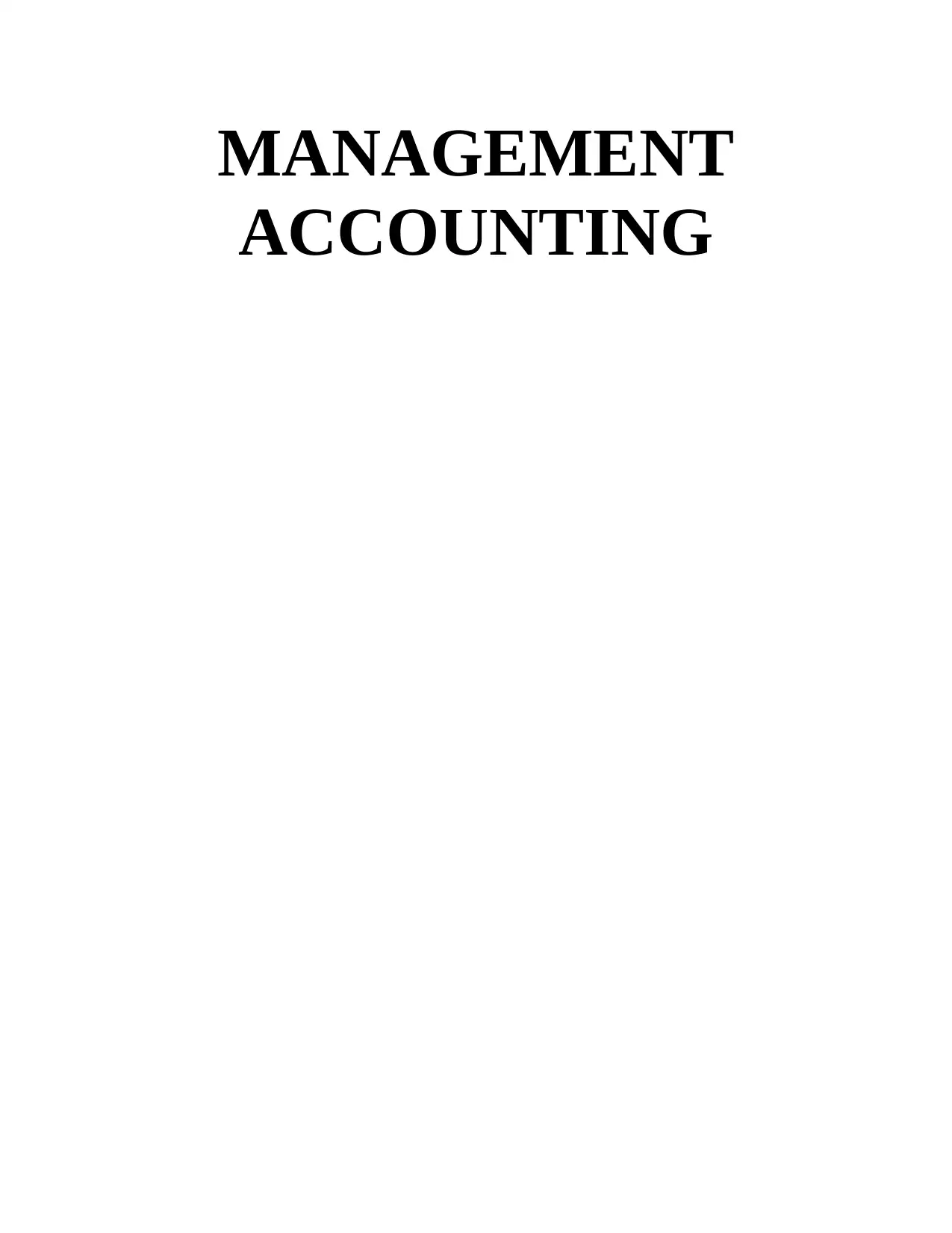
MANAGEMENT
ACCOUNTING
ACCOUNTING
Paraphrase This Document
Need a fresh take? Get an instant paraphrase of this document with our AI Paraphraser
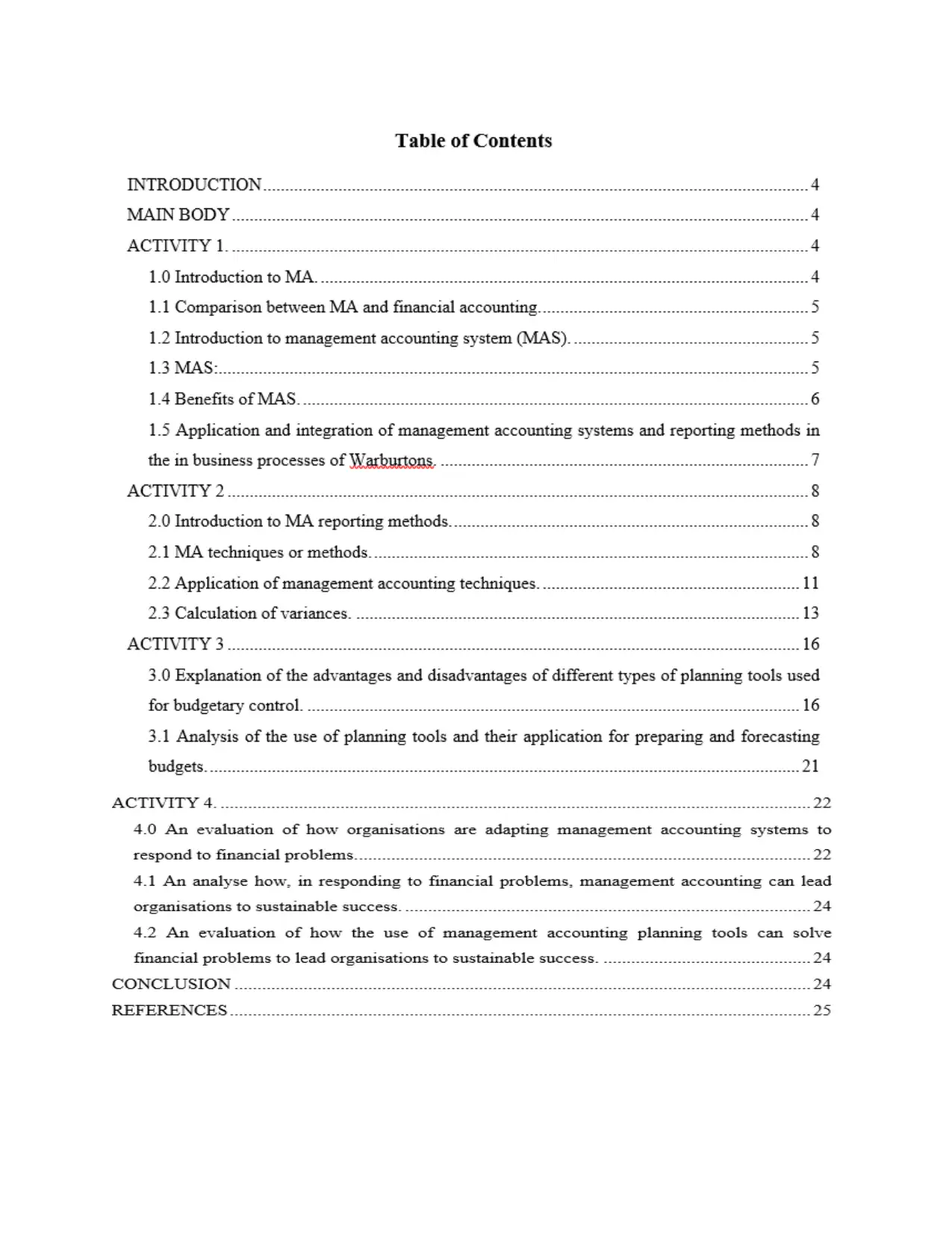
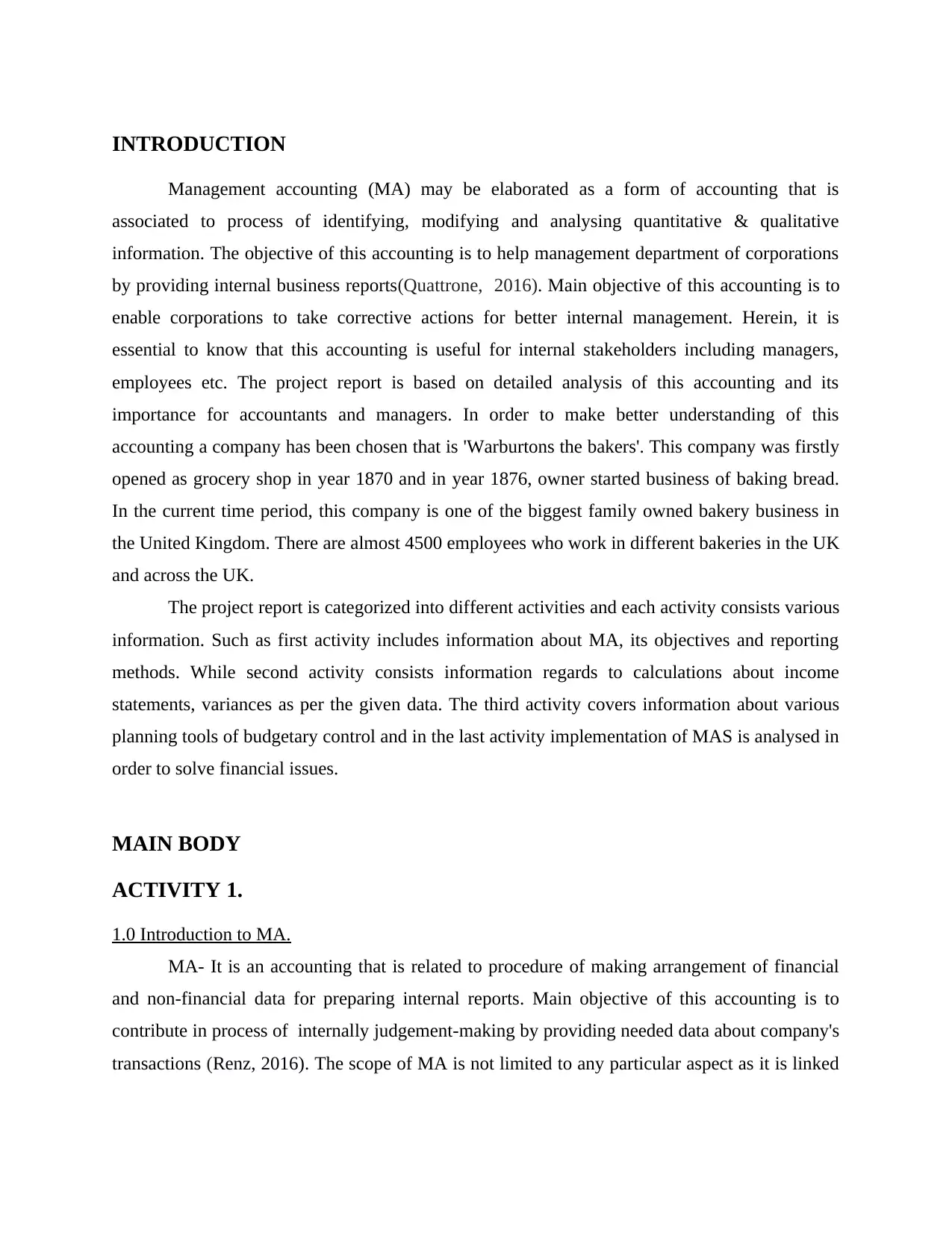
INTRODUCTION
Management accounting (MA) may be elaborated as a form of accounting that is
associated to process of identifying, modifying and analysing quantitative & qualitative
information. The objective of this accounting is to help management department of corporations
by providing internal business reports(Quattrone, 2016). Main objective of this accounting is to
enable corporations to take corrective actions for better internal management. Herein, it is
essential to know that this accounting is useful for internal stakeholders including managers,
employees etc. The project report is based on detailed analysis of this accounting and its
importance for accountants and managers. In order to make better understanding of this
accounting a company has been chosen that is 'Warburtons the bakers'. This company was firstly
opened as grocery shop in year 1870 and in year 1876, owner started business of baking bread.
In the current time period, this company is one of the biggest family owned bakery business in
the United Kingdom. There are almost 4500 employees who work in different bakeries in the UK
and across the UK.
The project report is categorized into different activities and each activity consists various
information. Such as first activity includes information about MA, its objectives and reporting
methods. While second activity consists information regards to calculations about income
statements, variances as per the given data. The third activity covers information about various
planning tools of budgetary control and in the last activity implementation of MAS is analysed in
order to solve financial issues.
MAIN BODY
ACTIVITY 1.
1.0 Introduction to MA.
MA- It is an accounting that is related to procedure of making arrangement of financial
and non-financial data for preparing internal reports. Main objective of this accounting is to
contribute in process of internally judgement-making by providing needed data about company's
transactions (Renz, 2016). The scope of MA is not limited to any particular aspect as it is linked
Management accounting (MA) may be elaborated as a form of accounting that is
associated to process of identifying, modifying and analysing quantitative & qualitative
information. The objective of this accounting is to help management department of corporations
by providing internal business reports(Quattrone, 2016). Main objective of this accounting is to
enable corporations to take corrective actions for better internal management. Herein, it is
essential to know that this accounting is useful for internal stakeholders including managers,
employees etc. The project report is based on detailed analysis of this accounting and its
importance for accountants and managers. In order to make better understanding of this
accounting a company has been chosen that is 'Warburtons the bakers'. This company was firstly
opened as grocery shop in year 1870 and in year 1876, owner started business of baking bread.
In the current time period, this company is one of the biggest family owned bakery business in
the United Kingdom. There are almost 4500 employees who work in different bakeries in the UK
and across the UK.
The project report is categorized into different activities and each activity consists various
information. Such as first activity includes information about MA, its objectives and reporting
methods. While second activity consists information regards to calculations about income
statements, variances as per the given data. The third activity covers information about various
planning tools of budgetary control and in the last activity implementation of MAS is analysed in
order to solve financial issues.
MAIN BODY
ACTIVITY 1.
1.0 Introduction to MA.
MA- It is an accounting that is related to procedure of making arrangement of financial
and non-financial data for preparing internal reports. Main objective of this accounting is to
contribute in process of internally judgement-making by providing needed data about company's
transactions (Renz, 2016). The scope of MA is not limited to any particular aspect as it is linked
⊘ This is a preview!⊘
Do you want full access?
Subscribe today to unlock all pages.

Trusted by 1+ million students worldwide
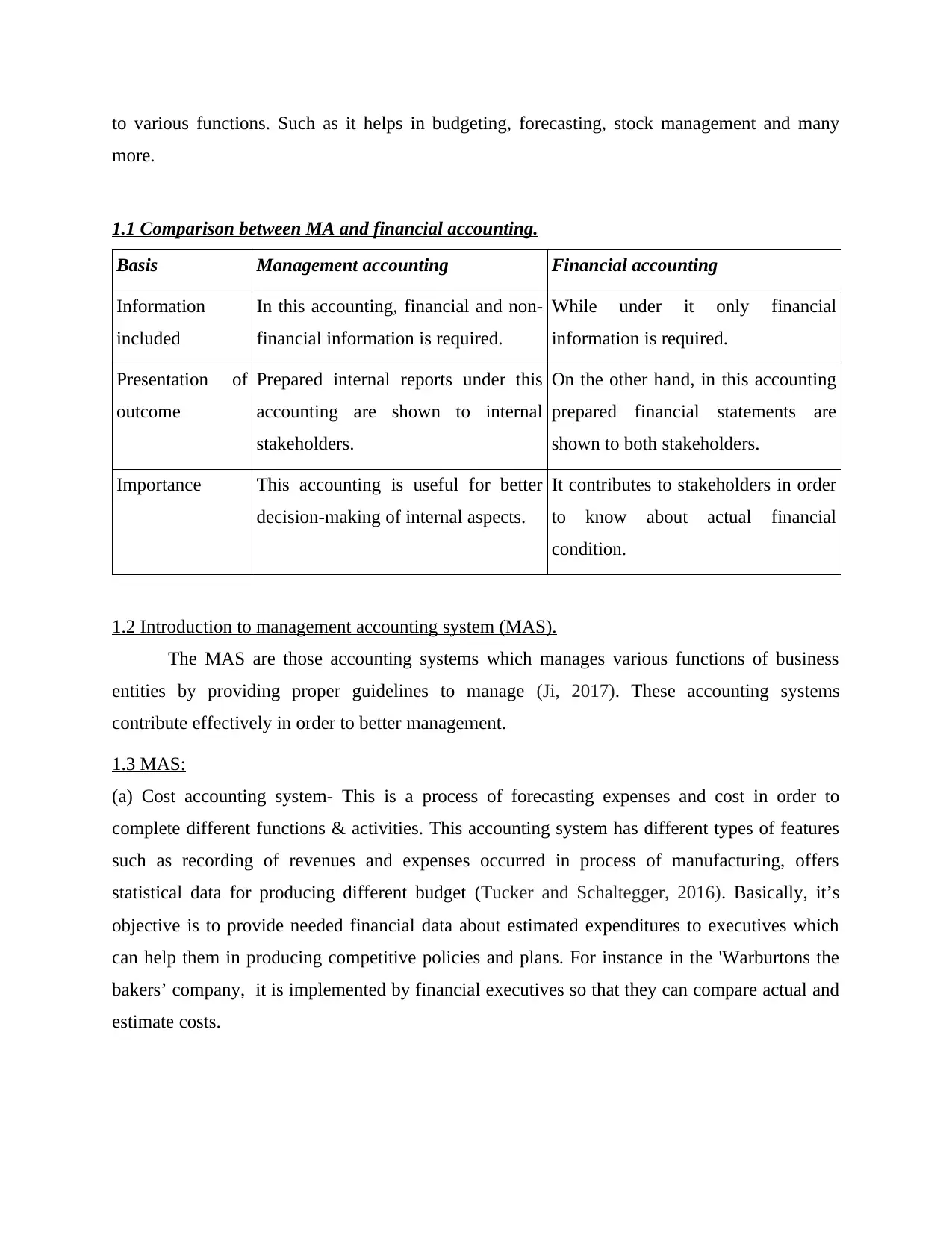
to various functions. Such as it helps in budgeting, forecasting, stock management and many
more.
1.1 Comparison between MA and financial accounting.
Basis Management accounting Financial accounting
Information
included
In this accounting, financial and non-
financial information is required.
While under it only financial
information is required.
Presentation of
outcome
Prepared internal reports under this
accounting are shown to internal
stakeholders.
On the other hand, in this accounting
prepared financial statements are
shown to both stakeholders.
Importance This accounting is useful for better
decision-making of internal aspects.
It contributes to stakeholders in order
to know about actual financial
condition.
1.2 Introduction to management accounting system (MAS).
The MAS are those accounting systems which manages various functions of business
entities by providing proper guidelines to manage (Ji, 2017). These accounting systems
contribute effectively in order to better management.
1.3 MAS:
(a) Cost accounting system- This is a process of forecasting expenses and cost in order to
complete different functions & activities. This accounting system has different types of features
such as recording of revenues and expenses occurred in process of manufacturing, offers
statistical data for producing different budget (Tucker and Schaltegger, 2016). Basically, it’s
objective is to provide needed financial data about estimated expenditures to executives which
can help them in producing competitive policies and plans. For instance in the 'Warburtons the
bakers’ company, it is implemented by financial executives so that they can compare actual and
estimate costs.
more.
1.1 Comparison between MA and financial accounting.
Basis Management accounting Financial accounting
Information
included
In this accounting, financial and non-
financial information is required.
While under it only financial
information is required.
Presentation of
outcome
Prepared internal reports under this
accounting are shown to internal
stakeholders.
On the other hand, in this accounting
prepared financial statements are
shown to both stakeholders.
Importance This accounting is useful for better
decision-making of internal aspects.
It contributes to stakeholders in order
to know about actual financial
condition.
1.2 Introduction to management accounting system (MAS).
The MAS are those accounting systems which manages various functions of business
entities by providing proper guidelines to manage (Ji, 2017). These accounting systems
contribute effectively in order to better management.
1.3 MAS:
(a) Cost accounting system- This is a process of forecasting expenses and cost in order to
complete different functions & activities. This accounting system has different types of features
such as recording of revenues and expenses occurred in process of manufacturing, offers
statistical data for producing different budget (Tucker and Schaltegger, 2016). Basically, it’s
objective is to provide needed financial data about estimated expenditures to executives which
can help them in producing competitive policies and plans. For instance in the 'Warburtons the
bakers’ company, it is implemented by financial executives so that they can compare actual and
estimate costs.
Paraphrase This Document
Need a fresh take? Get an instant paraphrase of this document with our AI Paraphraser
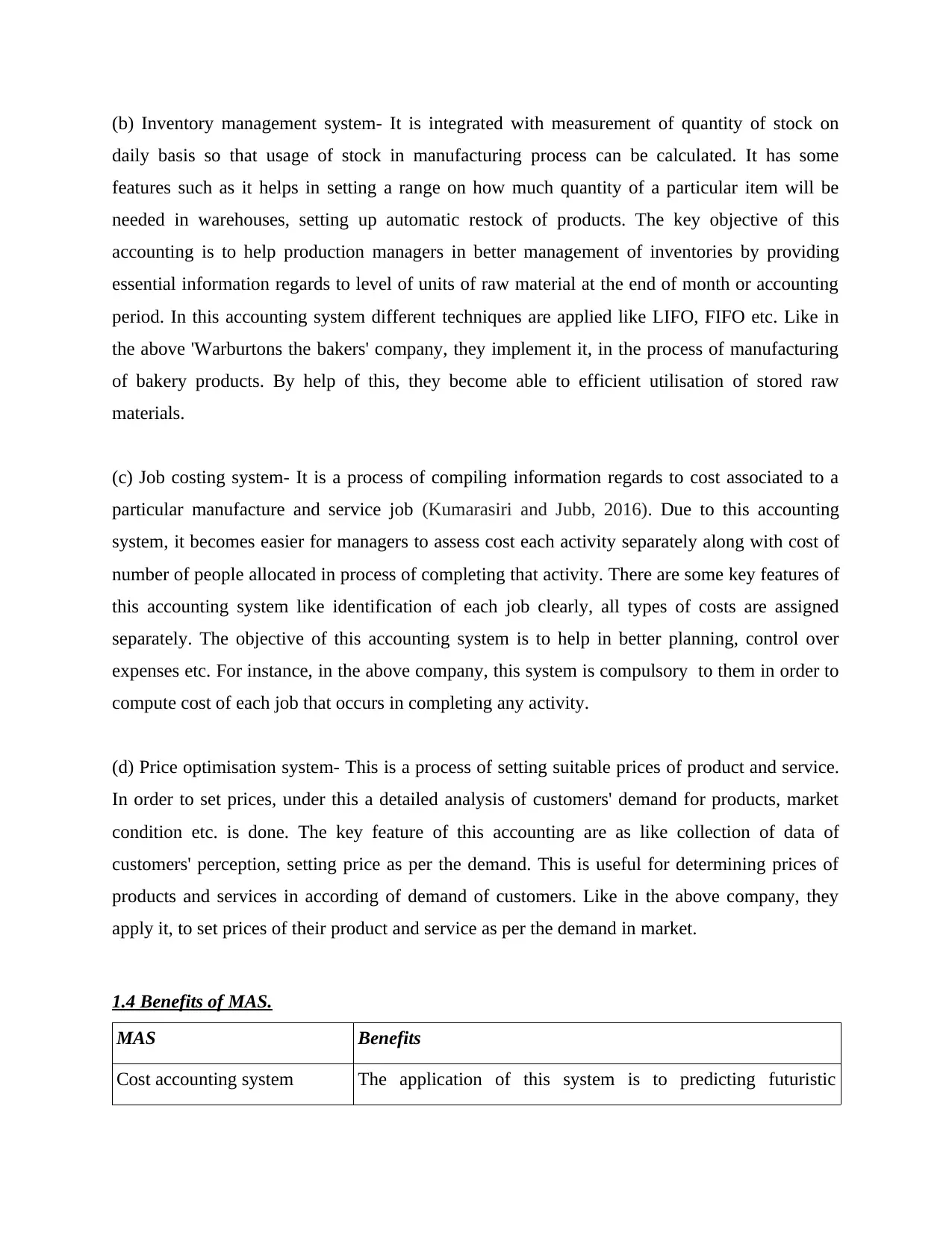
(b) Inventory management system- It is integrated with measurement of quantity of stock on
daily basis so that usage of stock in manufacturing process can be calculated. It has some
features such as it helps in setting a range on how much quantity of a particular item will be
needed in warehouses, setting up automatic restock of products. The key objective of this
accounting is to help production managers in better management of inventories by providing
essential information regards to level of units of raw material at the end of month or accounting
period. In this accounting system different techniques are applied like LIFO, FIFO etc. Like in
the above 'Warburtons the bakers' company, they implement it, in the process of manufacturing
of bakery products. By help of this, they become able to efficient utilisation of stored raw
materials.
(c) Job costing system- It is a process of compiling information regards to cost associated to a
particular manufacture and service job (Kumarasiri and Jubb, 2016). Due to this accounting
system, it becomes easier for managers to assess cost each activity separately along with cost of
number of people allocated in process of completing that activity. There are some key features of
this accounting system like identification of each job clearly, all types of costs are assigned
separately. The objective of this accounting system is to help in better planning, control over
expenses etc. For instance, in the above company, this system is compulsory to them in order to
compute cost of each job that occurs in completing any activity.
(d) Price optimisation system- This is a process of setting suitable prices of product and service.
In order to set prices, under this a detailed analysis of customers' demand for products, market
condition etc. is done. The key feature of this accounting are as like collection of data of
customers' perception, setting price as per the demand. This is useful for determining prices of
products and services in according of demand of customers. Like in the above company, they
apply it, to set prices of their product and service as per the demand in market.
1.4 Benefits of MAS.
MAS Benefits
Cost accounting system The application of this system is to predicting futuristic
daily basis so that usage of stock in manufacturing process can be calculated. It has some
features such as it helps in setting a range on how much quantity of a particular item will be
needed in warehouses, setting up automatic restock of products. The key objective of this
accounting is to help production managers in better management of inventories by providing
essential information regards to level of units of raw material at the end of month or accounting
period. In this accounting system different techniques are applied like LIFO, FIFO etc. Like in
the above 'Warburtons the bakers' company, they implement it, in the process of manufacturing
of bakery products. By help of this, they become able to efficient utilisation of stored raw
materials.
(c) Job costing system- It is a process of compiling information regards to cost associated to a
particular manufacture and service job (Kumarasiri and Jubb, 2016). Due to this accounting
system, it becomes easier for managers to assess cost each activity separately along with cost of
number of people allocated in process of completing that activity. There are some key features of
this accounting system like identification of each job clearly, all types of costs are assigned
separately. The objective of this accounting system is to help in better planning, control over
expenses etc. For instance, in the above company, this system is compulsory to them in order to
compute cost of each job that occurs in completing any activity.
(d) Price optimisation system- This is a process of setting suitable prices of product and service.
In order to set prices, under this a detailed analysis of customers' demand for products, market
condition etc. is done. The key feature of this accounting are as like collection of data of
customers' perception, setting price as per the demand. This is useful for determining prices of
products and services in according of demand of customers. Like in the above company, they
apply it, to set prices of their product and service as per the demand in market.
1.4 Benefits of MAS.
MAS Benefits
Cost accounting system The application of this system is to predicting futuristic
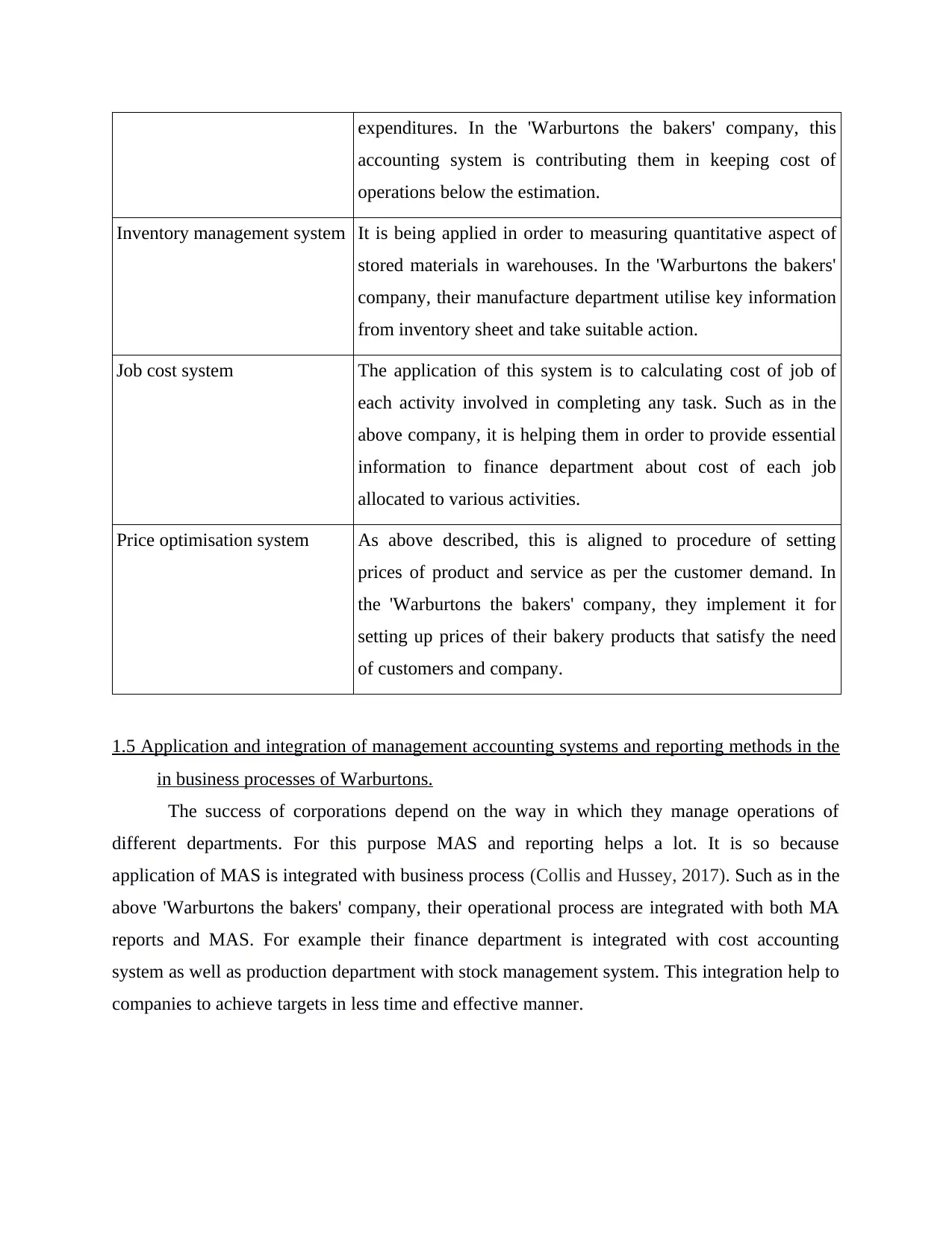
expenditures. In the 'Warburtons the bakers' company, this
accounting system is contributing them in keeping cost of
operations below the estimation.
Inventory management system It is being applied in order to measuring quantitative aspect of
stored materials in warehouses. In the 'Warburtons the bakers'
company, their manufacture department utilise key information
from inventory sheet and take suitable action.
Job cost system The application of this system is to calculating cost of job of
each activity involved in completing any task. Such as in the
above company, it is helping them in order to provide essential
information to finance department about cost of each job
allocated to various activities.
Price optimisation system As above described, this is aligned to procedure of setting
prices of product and service as per the customer demand. In
the 'Warburtons the bakers' company, they implement it for
setting up prices of their bakery products that satisfy the need
of customers and company.
1.5 Application and integration of management accounting systems and reporting methods in the
in business processes of Warburtons.
The success of corporations depend on the way in which they manage operations of
different departments. For this purpose MAS and reporting helps a lot. It is so because
application of MAS is integrated with business process (Collis and Hussey, 2017). Such as in the
above 'Warburtons the bakers' company, their operational process are integrated with both MA
reports and MAS. For example their finance department is integrated with cost accounting
system as well as production department with stock management system. This integration help to
companies to achieve targets in less time and effective manner.
accounting system is contributing them in keeping cost of
operations below the estimation.
Inventory management system It is being applied in order to measuring quantitative aspect of
stored materials in warehouses. In the 'Warburtons the bakers'
company, their manufacture department utilise key information
from inventory sheet and take suitable action.
Job cost system The application of this system is to calculating cost of job of
each activity involved in completing any task. Such as in the
above company, it is helping them in order to provide essential
information to finance department about cost of each job
allocated to various activities.
Price optimisation system As above described, this is aligned to procedure of setting
prices of product and service as per the customer demand. In
the 'Warburtons the bakers' company, they implement it for
setting up prices of their bakery products that satisfy the need
of customers and company.
1.5 Application and integration of management accounting systems and reporting methods in the
in business processes of Warburtons.
The success of corporations depend on the way in which they manage operations of
different departments. For this purpose MAS and reporting helps a lot. It is so because
application of MAS is integrated with business process (Collis and Hussey, 2017). Such as in the
above 'Warburtons the bakers' company, their operational process are integrated with both MA
reports and MAS. For example their finance department is integrated with cost accounting
system as well as production department with stock management system. This integration help to
companies to achieve targets in less time and effective manner.
⊘ This is a preview!⊘
Do you want full access?
Subscribe today to unlock all pages.

Trusted by 1+ million students worldwide
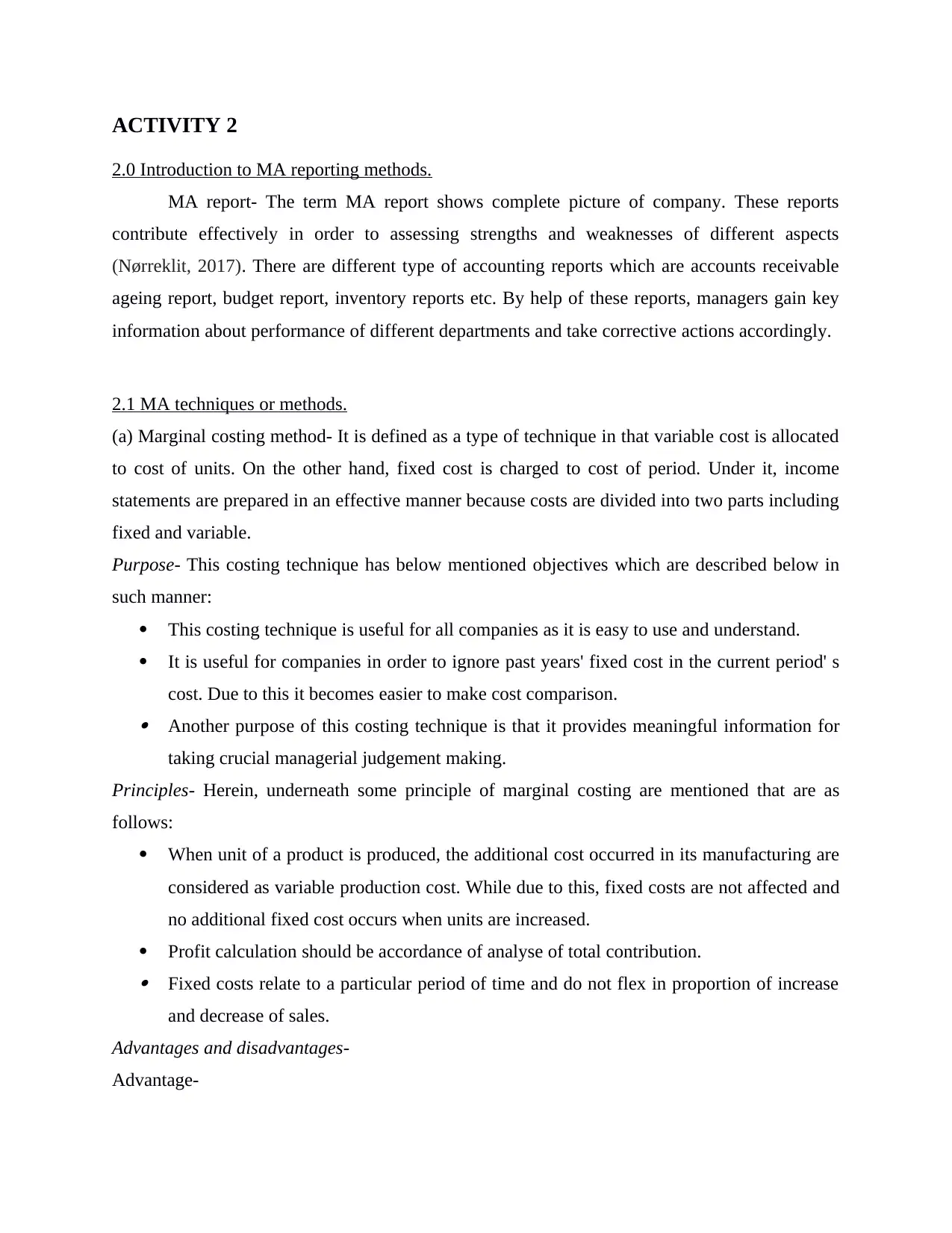
ACTIVITY 2
2.0 Introduction to MA reporting methods.
MA report- The term MA report shows complete picture of company. These reports
contribute effectively in order to assessing strengths and weaknesses of different aspects
(Nørreklit, 2017). There are different type of accounting reports which are accounts receivable
ageing report, budget report, inventory reports etc. By help of these reports, managers gain key
information about performance of different departments and take corrective actions accordingly.
2.1 MA techniques or methods.
(a) Marginal costing method- It is defined as a type of technique in that variable cost is allocated
to cost of units. On the other hand, fixed cost is charged to cost of period. Under it, income
statements are prepared in an effective manner because costs are divided into two parts including
fixed and variable.
Purpose- This costing technique has below mentioned objectives which are described below in
such manner:
This costing technique is useful for all companies as it is easy to use and understand.
It is useful for companies in order to ignore past years' fixed cost in the current period' s
cost. Due to this it becomes easier to make cost comparison. Another purpose of this costing technique is that it provides meaningful information for
taking crucial managerial judgement making.
Principles- Herein, underneath some principle of marginal costing are mentioned that are as
follows:
When unit of a product is produced, the additional cost occurred in its manufacturing are
considered as variable production cost. While due to this, fixed costs are not affected and
no additional fixed cost occurs when units are increased.
Profit calculation should be accordance of analyse of total contribution. Fixed costs relate to a particular period of time and do not flex in proportion of increase
and decrease of sales.
Advantages and disadvantages-
Advantage-
2.0 Introduction to MA reporting methods.
MA report- The term MA report shows complete picture of company. These reports
contribute effectively in order to assessing strengths and weaknesses of different aspects
(Nørreklit, 2017). There are different type of accounting reports which are accounts receivable
ageing report, budget report, inventory reports etc. By help of these reports, managers gain key
information about performance of different departments and take corrective actions accordingly.
2.1 MA techniques or methods.
(a) Marginal costing method- It is defined as a type of technique in that variable cost is allocated
to cost of units. On the other hand, fixed cost is charged to cost of period. Under it, income
statements are prepared in an effective manner because costs are divided into two parts including
fixed and variable.
Purpose- This costing technique has below mentioned objectives which are described below in
such manner:
This costing technique is useful for all companies as it is easy to use and understand.
It is useful for companies in order to ignore past years' fixed cost in the current period' s
cost. Due to this it becomes easier to make cost comparison. Another purpose of this costing technique is that it provides meaningful information for
taking crucial managerial judgement making.
Principles- Herein, underneath some principle of marginal costing are mentioned that are as
follows:
When unit of a product is produced, the additional cost occurred in its manufacturing are
considered as variable production cost. While due to this, fixed costs are not affected and
no additional fixed cost occurs when units are increased.
Profit calculation should be accordance of analyse of total contribution. Fixed costs relate to a particular period of time and do not flex in proportion of increase
and decrease of sales.
Advantages and disadvantages-
Advantage-
Paraphrase This Document
Need a fresh take? Get an instant paraphrase of this document with our AI Paraphraser
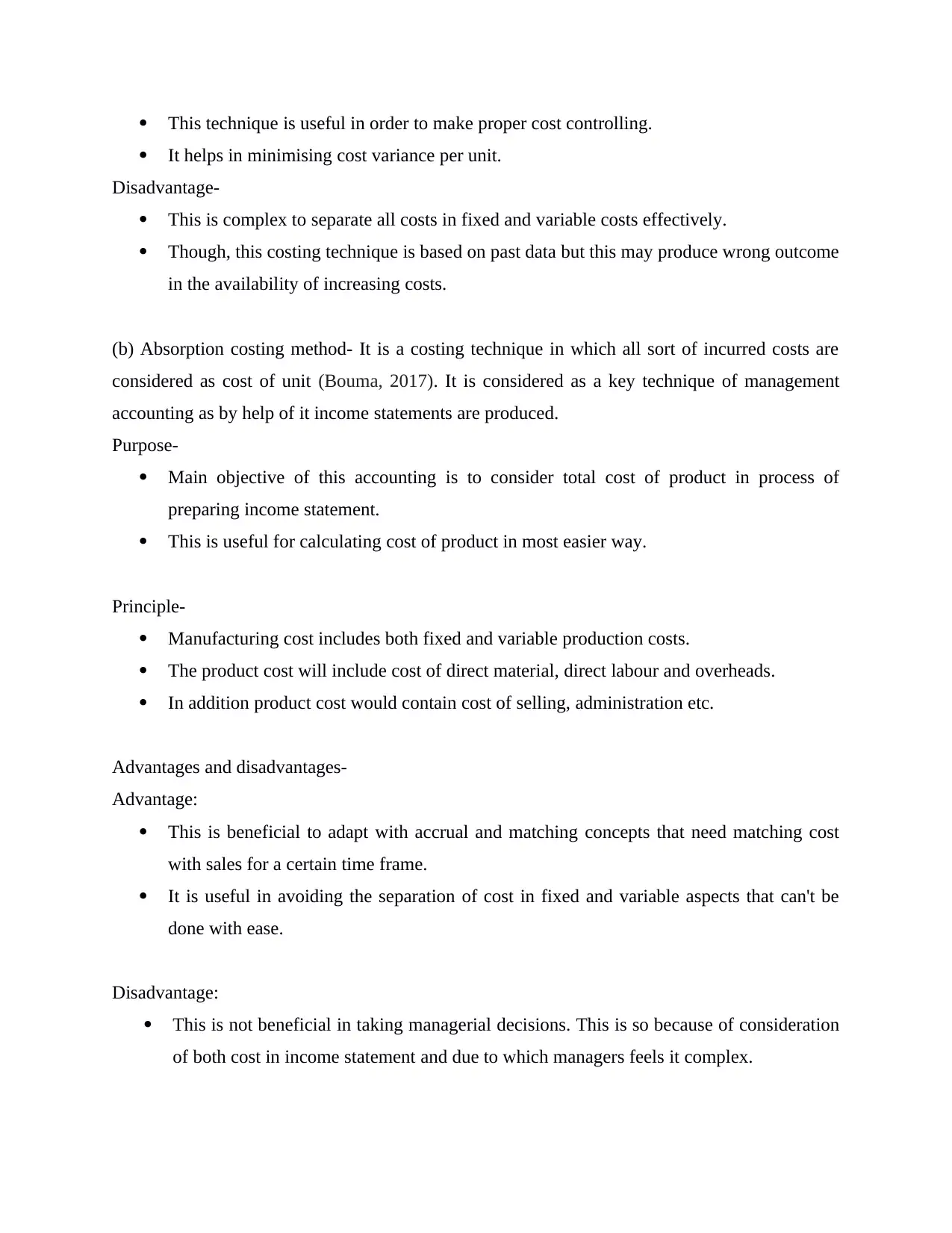
This technique is useful in order to make proper cost controlling.
It helps in minimising cost variance per unit.
Disadvantage-
This is complex to separate all costs in fixed and variable costs effectively.
Though, this costing technique is based on past data but this may produce wrong outcome
in the availability of increasing costs.
(b) Absorption costing method- It is a costing technique in which all sort of incurred costs are
considered as cost of unit (Bouma, 2017). It is considered as a key technique of management
accounting as by help of it income statements are produced.
Purpose-
Main objective of this accounting is to consider total cost of product in process of
preparing income statement.
This is useful for calculating cost of product in most easier way.
Principle-
Manufacturing cost includes both fixed and variable production costs.
The product cost will include cost of direct material, direct labour and overheads.
In addition product cost would contain cost of selling, administration etc.
Advantages and disadvantages-
Advantage:
This is beneficial to adapt with accrual and matching concepts that need matching cost
with sales for a certain time frame.
It is useful in avoiding the separation of cost in fixed and variable aspects that can't be
done with ease.
Disadvantage:
This is not beneficial in taking managerial decisions. This is so because of consideration
of both cost in income statement and due to which managers feels it complex.
It helps in minimising cost variance per unit.
Disadvantage-
This is complex to separate all costs in fixed and variable costs effectively.
Though, this costing technique is based on past data but this may produce wrong outcome
in the availability of increasing costs.
(b) Absorption costing method- It is a costing technique in which all sort of incurred costs are
considered as cost of unit (Bouma, 2017). It is considered as a key technique of management
accounting as by help of it income statements are produced.
Purpose-
Main objective of this accounting is to consider total cost of product in process of
preparing income statement.
This is useful for calculating cost of product in most easier way.
Principle-
Manufacturing cost includes both fixed and variable production costs.
The product cost will include cost of direct material, direct labour and overheads.
In addition product cost would contain cost of selling, administration etc.
Advantages and disadvantages-
Advantage:
This is beneficial to adapt with accrual and matching concepts that need matching cost
with sales for a certain time frame.
It is useful in avoiding the separation of cost in fixed and variable aspects that can't be
done with ease.
Disadvantage:
This is not beneficial in taking managerial decisions. This is so because of consideration
of both cost in income statement and due to which managers feels it complex.
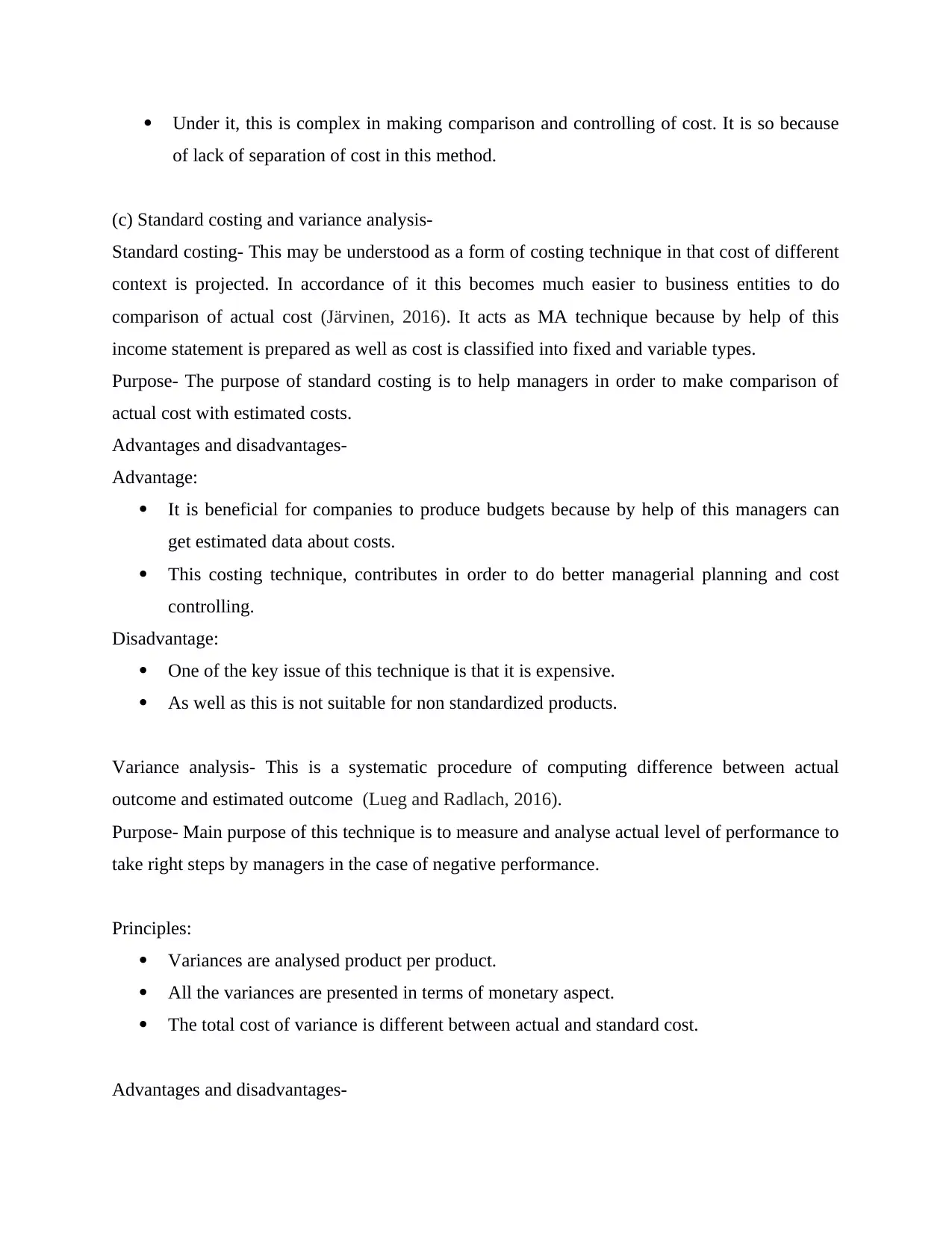
Under it, this is complex in making comparison and controlling of cost. It is so because
of lack of separation of cost in this method.
(c) Standard costing and variance analysis-
Standard costing- This may be understood as a form of costing technique in that cost of different
context is projected. In accordance of it this becomes much easier to business entities to do
comparison of actual cost (Järvinen, 2016). It acts as MA technique because by help of this
income statement is prepared as well as cost is classified into fixed and variable types.
Purpose- The purpose of standard costing is to help managers in order to make comparison of
actual cost with estimated costs.
Advantages and disadvantages-
Advantage:
It is beneficial for companies to produce budgets because by help of this managers can
get estimated data about costs.
This costing technique, contributes in order to do better managerial planning and cost
controlling.
Disadvantage:
One of the key issue of this technique is that it is expensive.
As well as this is not suitable for non standardized products.
Variance analysis- This is a systematic procedure of computing difference between actual
outcome and estimated outcome (Lueg and Radlach, 2016).
Purpose- Main purpose of this technique is to measure and analyse actual level of performance to
take right steps by managers in the case of negative performance.
Principles:
Variances are analysed product per product.
All the variances are presented in terms of monetary aspect.
The total cost of variance is different between actual and standard cost.
Advantages and disadvantages-
of lack of separation of cost in this method.
(c) Standard costing and variance analysis-
Standard costing- This may be understood as a form of costing technique in that cost of different
context is projected. In accordance of it this becomes much easier to business entities to do
comparison of actual cost (Järvinen, 2016). It acts as MA technique because by help of this
income statement is prepared as well as cost is classified into fixed and variable types.
Purpose- The purpose of standard costing is to help managers in order to make comparison of
actual cost with estimated costs.
Advantages and disadvantages-
Advantage:
It is beneficial for companies to produce budgets because by help of this managers can
get estimated data about costs.
This costing technique, contributes in order to do better managerial planning and cost
controlling.
Disadvantage:
One of the key issue of this technique is that it is expensive.
As well as this is not suitable for non standardized products.
Variance analysis- This is a systematic procedure of computing difference between actual
outcome and estimated outcome (Lueg and Radlach, 2016).
Purpose- Main purpose of this technique is to measure and analyse actual level of performance to
take right steps by managers in the case of negative performance.
Principles:
Variances are analysed product per product.
All the variances are presented in terms of monetary aspect.
The total cost of variance is different between actual and standard cost.
Advantages and disadvantages-
⊘ This is a preview!⊘
Do you want full access?
Subscribe today to unlock all pages.

Trusted by 1+ million students worldwide
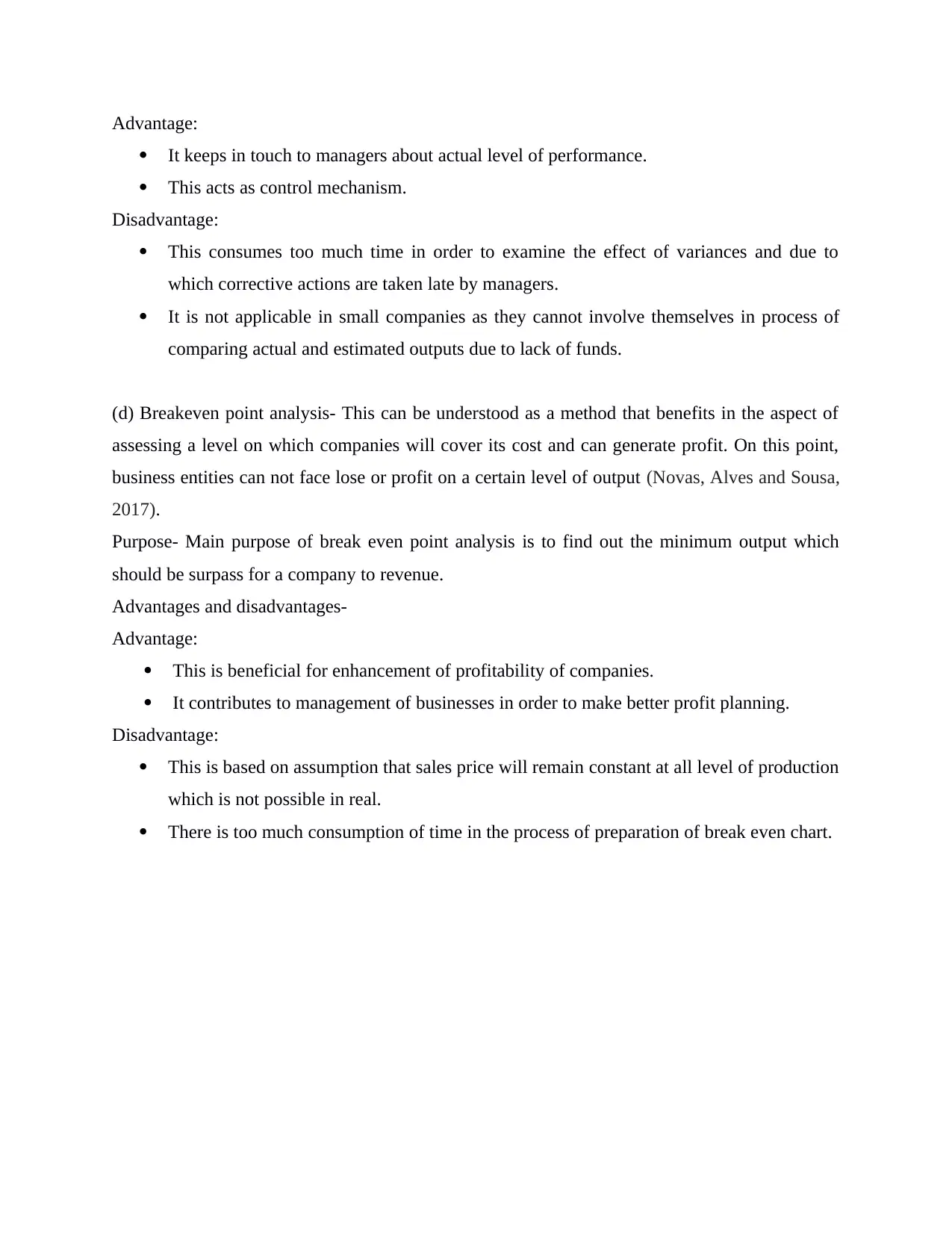
Advantage:
It keeps in touch to managers about actual level of performance.
This acts as control mechanism.
Disadvantage:
This consumes too much time in order to examine the effect of variances and due to
which corrective actions are taken late by managers.
It is not applicable in small companies as they cannot involve themselves in process of
comparing actual and estimated outputs due to lack of funds.
(d) Breakeven point analysis- This can be understood as a method that benefits in the aspect of
assessing a level on which companies will cover its cost and can generate profit. On this point,
business entities can not face lose or profit on a certain level of output (Novas, Alves and Sousa,
2017).
Purpose- Main purpose of break even point analysis is to find out the minimum output which
should be surpass for a company to revenue.
Advantages and disadvantages-
Advantage:
This is beneficial for enhancement of profitability of companies.
It contributes to management of businesses in order to make better profit planning.
Disadvantage:
This is based on assumption that sales price will remain constant at all level of production
which is not possible in real.
There is too much consumption of time in the process of preparation of break even chart.
It keeps in touch to managers about actual level of performance.
This acts as control mechanism.
Disadvantage:
This consumes too much time in order to examine the effect of variances and due to
which corrective actions are taken late by managers.
It is not applicable in small companies as they cannot involve themselves in process of
comparing actual and estimated outputs due to lack of funds.
(d) Breakeven point analysis- This can be understood as a method that benefits in the aspect of
assessing a level on which companies will cover its cost and can generate profit. On this point,
business entities can not face lose or profit on a certain level of output (Novas, Alves and Sousa,
2017).
Purpose- Main purpose of break even point analysis is to find out the minimum output which
should be surpass for a company to revenue.
Advantages and disadvantages-
Advantage:
This is beneficial for enhancement of profitability of companies.
It contributes to management of businesses in order to make better profit planning.
Disadvantage:
This is based on assumption that sales price will remain constant at all level of production
which is not possible in real.
There is too much consumption of time in the process of preparation of break even chart.
Paraphrase This Document
Need a fresh take? Get an instant paraphrase of this document with our AI Paraphraser
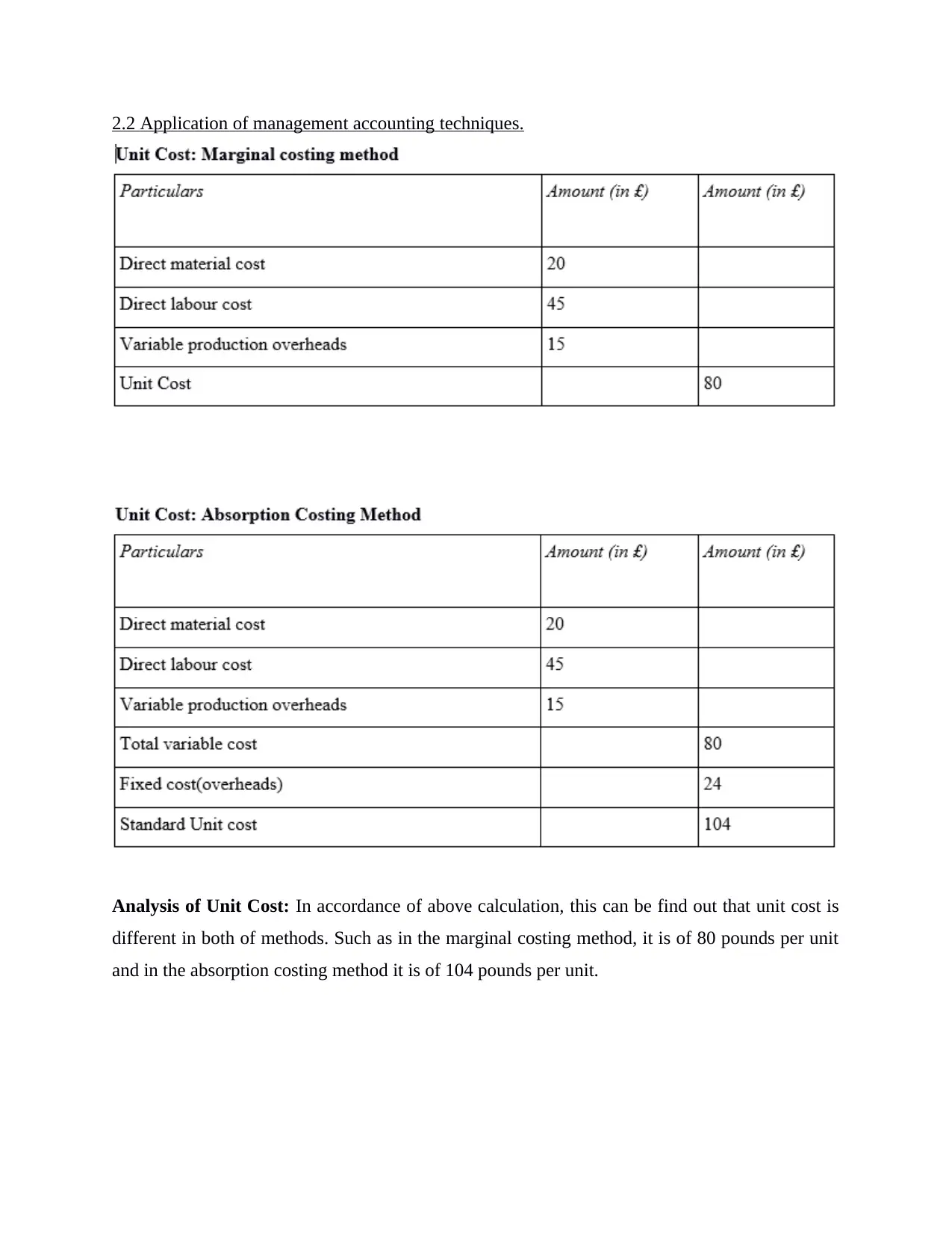
2.2 Application of management accounting techniques.
Analysis of Unit Cost: In accordance of above calculation, this can be find out that unit cost is
different in both of methods. Such as in the marginal costing method, it is of 80 pounds per unit
and in the absorption costing method it is of 104 pounds per unit.
Analysis of Unit Cost: In accordance of above calculation, this can be find out that unit cost is
different in both of methods. Such as in the marginal costing method, it is of 80 pounds per unit
and in the absorption costing method it is of 104 pounds per unit.
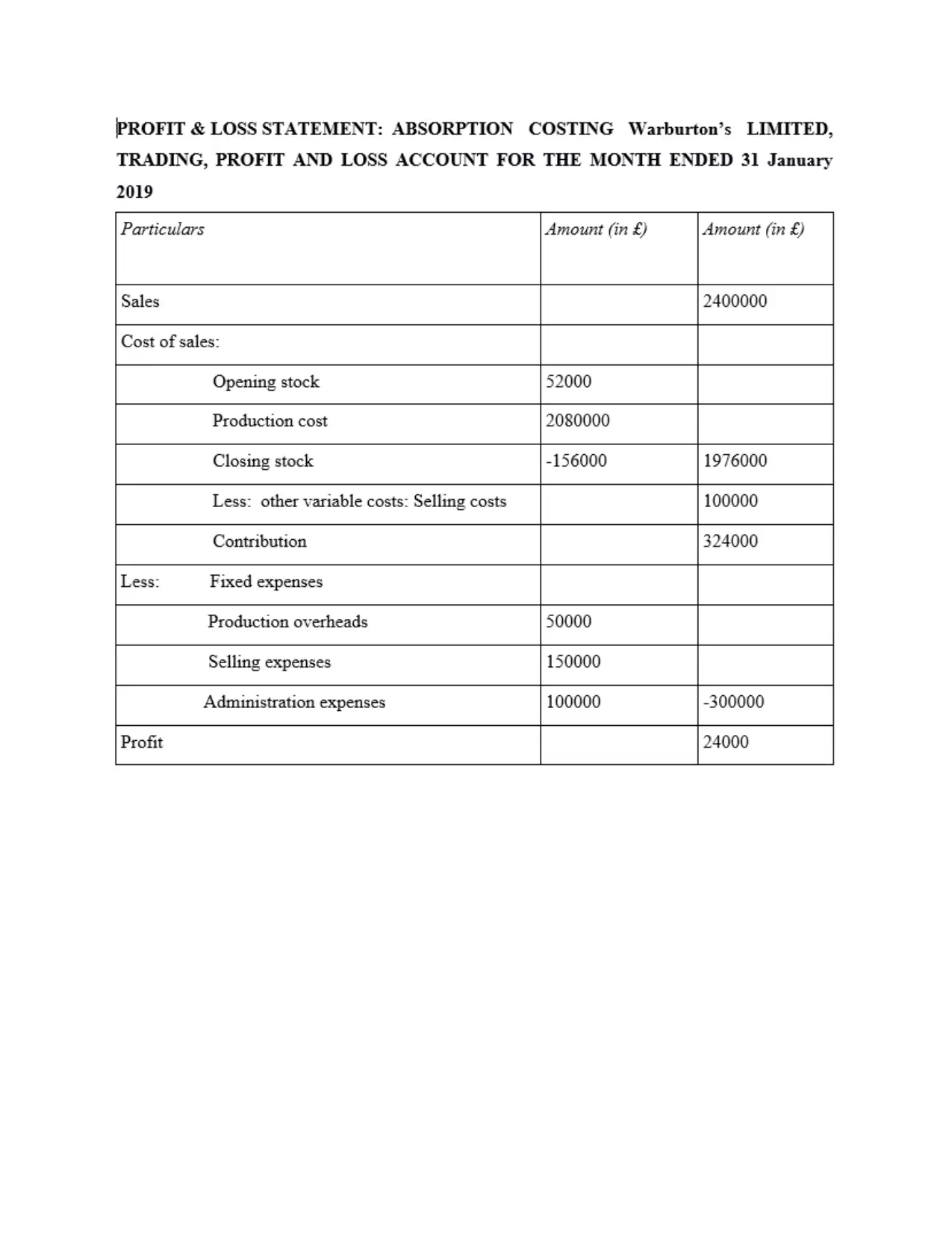
⊘ This is a preview!⊘
Do you want full access?
Subscribe today to unlock all pages.

Trusted by 1+ million students worldwide
1 out of 27
Related Documents
Your All-in-One AI-Powered Toolkit for Academic Success.
+13062052269
info@desklib.com
Available 24*7 on WhatsApp / Email
![[object Object]](/_next/static/media/star-bottom.7253800d.svg)
Unlock your academic potential
Copyright © 2020–2025 A2Z Services. All Rights Reserved. Developed and managed by ZUCOL.





